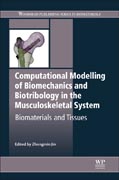
Computational Modelling of Biomechanics and Biotribology in the Musculoskeletal System: Biomaterials and Tissues
Jin, Z
Modelling is an important aspect of the design process for biomaterials and medical devices. By effectively modelling biomaterials and implants before their implantation, it is now possible to predict certain implant-tissue reactions, degradation and wear. Consequently, computational modelling is becoming increasingly important in the design and manufacture of biomedical materials, allowing scientists to more accurately tailor their materials' properties for the in vivo environment. Computational modelling of biomechanics and biotribology in the musculoskeletal system begins with an introduction to the field and the software and technologies. Part two covers generic modelling of cells and tissues whilst chapters in part three discuss modelling of biomaterials and interfaces. Part four reviews biomechanics and biotribology with chapters in part five discussing applications of modelling for joint replacements and tissue engineering. Covers generic modelling of cells and tissues; modelling of biomaterials and interfaces; biomechanics and biotribologyDiscusses applications of modelling for joint replacements and applications of computational modelling in tissue engineering INDICE: Part 1 Generic modelling of biomechanics and biotribology: Fundamentals of computational modelling of biomechanics in the musculoskeletal system; Finite element modelling in the musculoskeletal system: overview and generic; Joint wear simulation. Part 2 Computational modelling of musculoskeletal cells and tissues: Computational modeling of cell mechanics; Computational modelling of soft tissues and ligaments; Computational modeling of muscle biomechanics; Computational modelling of articular cartilage; Computational modeling of bone and bone remodelling; Modelling fracture processes in bones. Part 3 Computational modelling of orthopaedic biomaterials and interfaces: Modelling fatigue of bone cement; Modelling fracture processes in orthopaedic implants; Modelling cementless cup fixation in total hip arthroplasty (THA). Part 4 Applications of computational modelling for joint replacements and tissue scaffolds: Computational modeling of hip implants; Computational modelling of knee implants; Computational modelling of spinal implants; Computer aided design and finite element modelling of bone tissue scaffolds.
- ISBN: 978-0-85709-661-6
- Editorial: Woodhead Publishing
- Encuadernacion: Cartoné
- Páginas: 570
- Fecha Publicación: 25/04/2014
- Nº Volúmenes: 1
- Idioma: Inglés
